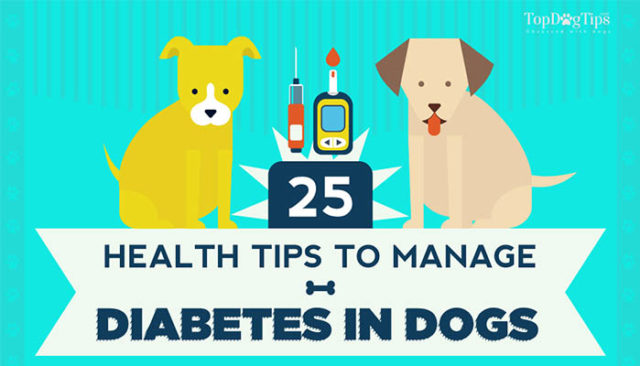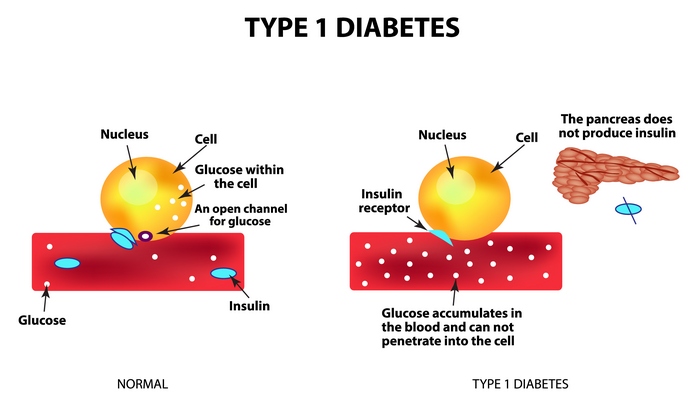
Table of Contents
Diabetes is a disease of the endocrine system which manages everything including hormones, metabolism, growth, and development in the dog.
In the case of diabetes in dogs, the body either doesn’t produce any or doesn’t produce enough insulin.
Insulin is a hormone that delivers energy to every part of the pet's body, so this can then result in the starvation of organs.
Knowing how to manage diabetes in dogs properly is essential if you believe your Fido is at risk.
Here's an infographic on health tips and 25 ways to manage diabetes in dogs:
Like this infographic? Spread the word! Share it on your site:
<p><strong>Please include attribution to topdogtips.org with this graphic.</strong></p><p><a href="https://topdogtips.org/diabetes-in-dogs/"><img src="https://topdogtips.org/img/Dog-Diabetes.jpg" alt="25 Ways to Manage Diabetes in Dogs" border="0" /></a></p>
Diabetes in Dogs: Ways to prevent and treat canine diabetes
If you suspect that your dog may be suffering from diabetes, you should go and see your veterinarian immediately.
The corresponding hypoglycemia that your dog can suffer from with inadequate insulin can result in severe health conditions and even death.
The most common and easy-to-spot symptoms associated with diabetes in dogs include the following:
- increased urination
- weight loss
- glossed over eyes
- excessive thirst
- growth in appetite
- seizures
- fatigue
With that in mind, here's everything you should know about diabetes in dogs.
READ THIS: 15 Tips On Diabetic Dog Food and How to Feed Dogs with Diabetes
What is Diabetes in Dogs?
We’ve all heard of diabetes and the rise of the disease throughout the human population.
But did you know that this increase also correlates with the rise in the canine population?
Often attributed to poor diet, diabetes is, in essence, a disease caused by either a lack of insulin or the body's inability to respond to insulin.
Insulin is a hormone, and it’s an incredibly important part of the digestive process.
It is ordinarily produced after your dog has eaten food in order to carry the food to power different areas of the body.
In a diabetic dog, this delivery system essentially breaks down or leaves all of the fuel just floating around in the bloodstream instead of getting into the cells that need it.
The two types of diabetes most commonly found in canines are Type 1 and Type 2.
Type 1 Diabetes in dogs
Those suffering from this variant of diabetes in dogs are insulin-dependent, and the condition is characterized by the body's inability to produce its own insulin.
The pancreas is the super organ that is in charge of producing insulin and digestive enzymes, but in this scenario, it’s not doing its job.
You may be wondering why the pancreas ceases to produce insulin in the first place, and you’re not alone. Much research has been done to determine the root cause.
The stop in production is caused by the immune system being incorrectly triggered to attack the beta cells within the pancreas that would have ultimately been turned into insulin.
This attack on the Pancreas eventually makes it impossible for the organ to produce any insulin, which is often why the condition isn’t discovered in puppies and young dogs—as that’s when the pancreas is still fighting to produce the hormone.
Not enough is known about why the body begins to attack itself, but environmental and genetic factors do come into play, with the majority of Type 1 diabetes cases being hereditary.
Type 2 Diabetes in dogs
More common within cats but also seen on occasion in dogs, this variant starts out with the body no longer being able to correctly utilize the insulin that’s present.
That can result in blood glucose levels becoming too high or too low. Most often, this type of diabetes means that the pancreas is not producing enough insulin to get the job done.
How Serious is Diabetes in Dogs?
Diabetes is classified as a serious health condition, as without treatment or medication, the condition results in hyperglycemia, which can lead to more health problems, including cataracts, severe urinary tract infections, and ultimately become fatal.
However, with correct medication and management, most animals are able to lead full, healthy, and active lives!
Life expectancy is pretty much unaffected with diabetes in dogs, with those diagnosed early having the longest lives.
If your dog has recently been diagnosed, you can expect him to live to the same age as other dogs of his size and breed.
Symptoms of this condition include:
- frequent urination
- unquenchable thirst
- ravenous hunger
- weight loss
- lethargy
- vomiting
- thinning of hair
- dullness to coat
- cloudy eyes
- listlessness
Causes of Diabetes in Dogs
A common endocrine disorder, diabetes, usually occurs or is diagnosed in older dogs. The majority of diagnoses occur in patients over the age of seven. However, age isn't the only factor that plays a part in diabetes in dogs.
1. Autoimmune Conditions
One of the biggest nongenetic causes of diabetes is damage to the pancreas, usually attributed to autoimmune conditions. Environmental factors play a large role in the development of autoimmune conditions and can often be delayed or halted with pro-active lifestyle management.
One of the most common causes for canines developing autoimmune conditions is a foreign irritant confusing the body’s defenses. This can be anything from chemical sensitivity to certain cleaning products or to drugs that your pooch may be taking for another medical condition.
You can help to defend against the onset of autoimmune disease or lessen the effects of an already diagnosed condition through all-natural diets, strict exercise plans, and, as strange as it sounds—stress management.
You know that saying emotions are contagious, well, they are to our dogs too.
So if we’re always rushing around being stressed out, this energy will pass onto our poor little pooches and leave them feeling a bit stressed out.
Managing your own stress levels and making sure that there is plenty of downtime for you and your pup is going to be great not only for his health but for yours too!
2. Genetic Predisposition
There is a higher risk factor for some breeds when it comes to developing diabetes in dogs, and little is known as to why these breeds, in particular, have a higher likelihood of diabetes.
Breeds currently known to be at a higher risk include:
Small Breeds
- Cairn Terrier
- Dachshund
- Miniature Schnauzer
- Miniature Pinscher
- Miniature Poodle
- West Highland White Terrier
Medium Breeds
- Beagle
- Keeshond
- Poodle
- Finnish Spitz
- Chow Chow
- Springer Spaniel
- Samoyed
- Labrador
Large Breeds
- Doberman
- Golden Retriever
- Hungarian Puli
- Alaskan Malamute
- Old English Sheepdog
- German Shepherd
Preventing this is pretty much an uphill battle, but you can lessen your likelihood by doing thorough research on the breeder and the health of their past litters prior to bringing a new puppy home.
More than just helping yourself, by taking these steps (and hoping that others do the same), you’re helping to shape the dog breeding industry as a whole by demanding healthy breeding practices.
RELATED: Dog Food for Dogs with Diabetes – What You Need To Know
3. Inflammation
When the pancreas becomes inflamed, this disrupts the flow of digestive enzymes required for the body to function at an ideal capacity.
Rather than these enzymes being where they should, in the digestive tract; they are pushed into the abdominal area which results in the body essentially trying to digest itself.
Whilst inflammation of the pancreas can be caused by a genetic predisposition, one major reason that veterinarians see this condition is due to poor diet and obesity.
This damages a plethora of surrounding healthy cells, including the liver and kidneys, in some cases.
Many don’t appreciate the importance of good digestive health and consider this to be only of minor significance to their and their dog’s overall health.
This is just plain wrong.
It would be akin to assuming that your car will run perfectly with holes in the gas tank and gas pouring into your vehicle.
Some dogs simply are more naturally predisposed to inflammation, but with careful management of their diet, which excludes known irritants and feeding small and often—you can do a great deal towards lessening the problem.
Ultimately, you could be saving him from developing diabetes— and let’s be honest, you’d be saving yourself a lot of money on the lifelong medical treatment that goes along with it!
4. Obesity
We’ve all seen the figures on the disturbing rise in the instances of obesity and diabetes within the human population, so you’ll likely be unsurprised to hear that this is becoming equally as prevalent in our pet population.
Between the years 2006 and 2015 alone, research shows that the diagnosis of diabetes for dogs in the US has grown by a staggering 79.7%.
Veterinarians can have a hard time getting the message across to pet owners on the importance of a healthy weight and adequate exercise.
This is unsurprising, as it’s a tough subject to talk about, especially as, in many cases, the owners themselves may lead a sedentary lifestyle and have an emotional attachment to food.
This can lead the owner to give their dog extra treats. In their mind—they are showing them love and kindness.
As the saying goes, sometimes you have to be cruel to be kind, and veterinarians across the country are working together to come up with a realistic solution to this problem before it can go further.
The first line of defense is to have your dog on a regular feeding schedule, and if you absolutely must give him treats—make sure that they make up no more than 10% of his daily caloric intake.
TRY THIS: Homemade Diabetic Dog Food Recipe
Home Relief and Prevention of Diabetes in Dogs
Once your dog has been diagnosed with diabetes, there is nothing that you can do to cure the condition.
However, as with most health issues in dogs, there are many things that you can do to prevent early-onset diabetes and maybe even prevent Fido from being diagnosed with it at all.
1. Exercise
With obesity known to be the leading catalyst in diabetes, it’s important to keep your animals physically healthy to prevent or manage this disease.
This is especially important for those with a genetic predisposition towards developing the disease.
For diabetic dogs, it’s important to keep their exercise consistent in frequency, duration, and time of day.
Any unplanned exercise can cause you to become dangerously hypoglycemic, but of course, it can be hard to plan for every eventuality, so it’s a good idea to always have something sugary with you just in case. Packets of honey can work a treat!
If you’re worried that your dog may have a few extra pounds, I would strongly advise that you discuss a diet and exercise plan with your veterinarian to healthily bring him down to a good weight.
He will feel better for it, and thank you down the line when you’ve limited his risk to several deadly conditions.
2. The Ideal Diet
Diet plays one of the largest roles in managing and defending against canine diabetes. However, there are many misconceptions about the proper diet for a pup with diabetes.
For example, the fact that this disease affects blood sugar levels leads many to assume that feeding a diet low in sugar will be enough to protect your dog.
Actually, for diet or inflammation-induced diabetes, the most common cause is a diet too high in carbohydrates.
 One of the most important parts of feeding a diabetic dog is keeping to a routine.
One of the most important parts of feeding a diabetic dog is keeping to a routine.
And this is especially true when it comes to feeding times.
Always aim to feed your dog a minimum of two meals per day—preferably at a maximum of one hour prior to giving insulin shots.
This will help to defend against blood sugar spikes.
Fiber is an important part of a diabetic dog's diet. It is phenomenal at slowing the entrance of glucose into the bloodstream and allows for a more consistent blood sugar level.
Be cautious when feeding high-fiber diets to dogs that are already too thin, as this often promotes weight loss.
The weight loss can be managed, but it likely won’t help them to gain weight, which may be required depending on what your veterinarian has advised.
You'll also need to feed a diet low in carbohydrates and fat. Fido's meals should consist of a minimum of 40% protein, with less than 30% of his overall calories coming from fat and carbs.
Most pet food companies will be more than happy to help you find food that will work for your dog, so my first suggestion is to ask them.
Before changing your dog’s diet always consult your veterinarian, changes to the number of carbs he eats will require that his insulin doses are changed accordingly to avoid hypoglycemia episodes.
Likewise, be sure to find a protein-dense treat, as the majority contain predominantly carbs and sugars.
Having said that, if your dog suffers from low blood sugar dips throughout the day between insulin shots—you can work to find the correct time to give him a few sugary treats to keep him going until his next meal.
TRY THIS: Homemade Diabetic Dog Treat Recipe
Veterinary Treatment of Diabetes in Dogs
Home treatments may work for certain types of diabetic dogs.
However, when you spot symptoms of diabetes in dogs, you must contact your veterinarian, who will then recommend one of these two common dog diabetes treatments:
1. Insulin
Of course, the only real way to manage full-blown diabetes is through insulin shots, the dosage and frequency that these will be required will vary; but, on average, dogs require one to two shots per day.
This makes it pretty easy to fit in his additional health management with your normal day-to-day life.
2. Prescription Dog Food
Most diabetic dogs don’t require a prescription dog food for their diabetes itself—but some dogs suffering from this condition are likely to have additional medical issues, such as pancreatitis or obesity, that may require prescription diets. This, in turn, can have a beneficial effect on his diabetes! But, as always—only change his diet after consulting with your veterinarian.
Final Thoughts
Diabetes is a lifelong condition that will almost always require daily medication, but with proper care, management, and routines, your dog can live a long and happy life.
If your dog is ever left at doggy daycare, pet hotels, or with dog sitters, it’s absolutely vital that everyone who will be handling him at these establishments fully understands his condition.
It can be as easy as sending them a link to this article so that they know what to do, what not to do, and how to keep your four-legged friend healthy!
Diabetes in dogs is not something that will ever go away or get better. Once our dog is diagnosed, it's up to you to provide him with the proper care to keep the condition from worsening.
READ NEXT: Dealing with Canine Diabetes ft. Rachel Poulin, RVT
















